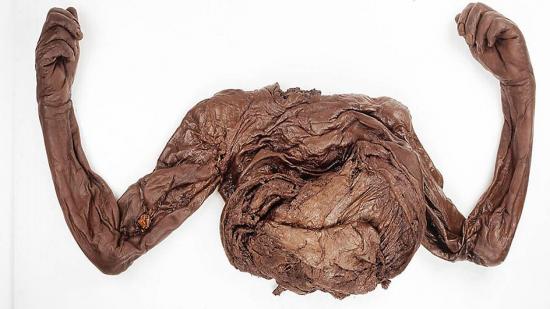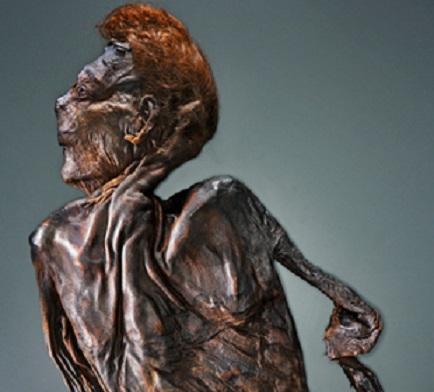Source - http://irisharchaeology.ie/2014/09/new-bog-body-found-in-rossan-co-meath/

New bog body remains (photo National Museum of Ireland)
Exciting news. The partial remains of a bog body has been uncovered in Rossan bog in Co. Meath. The find was discovered by Bord na Móna workers and subsequently excavated by a team of archaeologists, led by Maeve Sikora of the National Museum of Ireland. Although as yet undated the remains were found in an area that has previously produced bog body remains (Moydrum Man) that were radiocarbon dated to the Early Iron Age (700-400 BC).

Previous bog body remains from Rossan bog, Moydrum man (Photo National Museum of Ireland)
This latest addition to growing a corpus of Irish bog bodies will hopefully reveal as much information as two recent peat land discoveries. These aforementioned bog bodies, Old Croghan man and Clonycavan man, form the centre piece of the excellent Kingship and Sacrifice display at the National Museum of Ireland. What is striking about these remains is their fantastic state of preservation, something which is characteristic of bog bodies in general. This is primarily due to the cold, acidic, oxygen-free conditions that persist beneath peat bogs and which prevent decay and mummify human flesh.

Old Croghan man bog body
Old Croghan man was found in a bog beneath Croghan Hill in Co. Offaly and based on radiocarbon dating he died sometime between 362 BC and 175 BC . He was extremely tall measuring 6ft 6 in height and had well manicured hands suggesting that he was not used to manual labour. His last meal (analysed from the contents in his stomach) consisted of cereals and milk . However, he was shown to have had a meat rich diet for at least the 4 months prior to this (based on analysis of his nails). Clonycavan man, in contrast, was much smaller in stature, measuring just 5ft 2 in height. He was recovered from a bog in Co. Meath and only his upper torso and head survived. The remains were radiocarbon dated to between 392 BC and 201 BC and, unusually, his hair was spiked with pine resin (a very early form of hair gel). Furthermore, the trees from which the resin was sourced only grow in Spain and south-west France, indicating the presence of long distance trade routes.

Clonycavan man bog body
Both men had been subjected to gruesome deaths, suggesting that they may have been ritually tortured and murdered. Old Croghan man had holes cut in his upper arms through which a rope of hazel withies was threaded in order to restrain him. He was then stabbed, his nipples sliced, before finally being cut in half across his torso. Similar overkill was also seen on the Clonycavan bog body. He had been disembowelled and struck three times across the head with axe and once across the body. This brutality is not confined to Irish bog bodies and has been paralleled on human remains from British and continental bogs. For example, the Lindow man bog body, displayed at London’s British Museum, was struck twice on the head, garroted, and had his throat cut.
The reasons behind these bog body killings remains uncertain but Ned Kelly, formerly of the National Museum of Ireland, has suggested a very interesting theory (see Archaeology, No. 63, Vol 3, May/June 2010) . He believes that “these men were failed kings or failed candidates for kingship who were killed and placed in bogs that formed important tribal boundaries’.